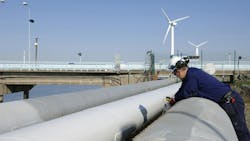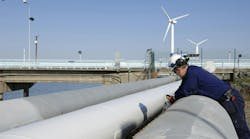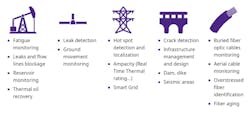Enhance Pipeline Monitoring with Fiber-Optic Sensing
What you'll learn:
- Traditional methods of pipeline monitoring.
- What is fiber-optic sensing?
- Practical use of distributed fiber-optic sensing (DFS).
- Real-world applications and benefits of DFS.
- Interpretation of data to prevent leaks.
Pipeline contents are typically valuable, volatile, and harmful to the environment if allowed to escape. With them being susceptible to aging, accidental damage, or tampering, the chances of an escape are very real—and this potential increases in remote, uninhabited areas through which they pass. Integrity monitoring is, therefore, essential.
Although primarily known for communications, fiber optics were first envisioned for vibration monitoring. The photonic sensor, an extrinsic fiber sensor for non-contact vibration measurements, was patented in 1967.
With an inherent immunity to electrical stimuli, long-distance transmission range, and corrosion resistance, fiber-optic communication components and infrastructure were quickly adopted for optical sensing. And, by the 1990s, distributed fiberoptic sensing (DFS) had become widely used for measuring temperature, strain, pressure, and acoustics, including by the oil and gas industry.
Traditional Methods of Pipeline Monitoring
Previously, technicians physically inspected pipelines, braving often inhospitable on-site conditions. And, as pipelines are typically buried, visual inspection can be limited from drones or helicopters.
Ground-penetrating radar (GPR) could be used, but this requires trained personnel and is limited by soil conditions and depth. Another alternative is acoustic emission testing. It can provide continuous monitoring but requires extensive sensor deployment, increasing costs. Conversely, pressure and flow monitoring can detect anomalies but (without the installation of many sensors, which significantly increases cost) lacks resolution.
>>Download the PDF of this article
As such, none of these methods were fully satisfactory. Many still involved periodic testing or missed small but potentially catastrophic issues, and achieving high-resolution was costly.
Fiber-Optic Sensing Technology
Fiber allows for two classes of sensing. Extrinsic sensing occurs when a simple communication path is provided between a test system and a sensor. Conversely, intrinsic fiber sensing occurs when the fiber itself acts as the sensing system. This requires no discrete interfaces between the fiber and external sensors, and therefore reduces complexity and cost.
The physical properties of light traveling along a fiber can be used to detect changes in parameters such as temperature, strain, vibration. Techniques can then be used to turn the fiber itself into the sensor, which makes it possible to generate thousands of continuous sensing points along its length. This is known as distributed fiber-optic sensing (DFS), with Raman, Brillouin, or Coherent Rayleigh backscattering DFS techniques implemented (Fig. 1).
Raman scattering is used for distributed temperature sensing (DTS), measuring the difference between the intensity of backscattered light in the Stokes and anti-Stokes bands. Similarly, Brillouin utilizes backscattered light wavelength and the predictable way it’s influenced by the external temperature and acoustic stimulations to additionally strain, as well as temperature variations (DTSS).
Conversely, Coherent Rayleigh scattering uses light photons scattered randomly by the fiber material to detect vibrations and acoustic waves. By analyzing the phase shifts of the light, it’s possible to pinpoint the location and intensity of the vibrations along the entire length of the fiber. Coherent Rayleigh is used for distributed acoustic sensing (DAS)
By using distributed fiber-optic sensors, pipeline operators can enable continuous measurement along the fiber's entire length, giving real-time data without installing thousands of individual sensors.
DFS can detect even minor stress or environmental shifts affecting the pipeline. And by integrating this with a monitoring system, operators can receive immediate alerts for potential pipeline failures, enabling rapid intervention and damage prevention.
Practical Use of DFS
Portable instruments with DTS and DTSS capabilities can be employed in the field. Meanwhile, platforms using rack-mounted fiber test heads with DTS, DTSS, or DAS capabilities enable fibers to be monitored for long periods, with automated alarms raised in the event of a change.
In Figure 2, a DTSS interrogator uses Brillouin OTDR (BOTDR). It emits a short pulse of light into the fiber-optic sensor, which then generates Brillouin backscattered light at two distinct wavelengths from all points along the fiber.
Building on this, the wavelengths of the Brillouin backscattered light differ from that of the forward incident light—they’re named "Stokes" and "anti-Stokes." Figure 3 shows that it’s possible to measure temperature and strain along the fiber by comparing the Stokes and Anti-stokes Brillouin levels and frequencies.
Real-World Applications and Benefits
While many traditional methods of detecting issues rely on a leak happening and being large enough to detect, DFS is far more sensitive and looks for any indication that a leak could happen.
In some cases, the first indication of a problem is a small leak. Traditional methods would likely struggle to detect such leaks, especially for an underground pipe. However, most leaks will make some sort of sound as the pipe contents start to escape. In this case, the use of DAS gives both a warning and a location at the earliest possible stage.
Through DFS, it’s also possible to measure stresses and strains in pipelines, with changes suggesting shifts in the soil surrounding the pipe, which can be caused by a landslip or earthquake. Of course, depending on the scale of stress, it can quickly lead to rupture. However, DTSS can pinpoint the issue to identify the location and prioritize repairs along the pipeline.
Beyond earth movements, human-caused damage can occur as an accident, with damage caused by construction work and the vehicle operator either unaware of the pipeline… or inaccurately calculating its position. Given the strategic importance of many pipelines, though, malicious activity is a realistic possibility with attempts made to steal or divert their contents.
In either situation, to reach the pipeline, digging will be required. This can be detected via DAS, pinpointing the exact location. Depending on the depth involved, sensitive DAS systems can even detect vehicles or pedestrians moving on the surface. While this may be perfectly normal for pipelines passing through urban areas, it signals a concern that merits investigation in remote locations.
And then there’s degradation, whereby a leak forms as a result of the pipeline’s relatively slow aging process. Again, DFS can identify and pinpoint the location of issues at an early stage, with preventative maintenance carried out at a lower cost and with minimal disruption.
Interpretation of Data to Prevent Leaks
Of course, the ability to detect backscattered light is one thing, but interpreting the data into real-world scenarios can be quite another. The ability to translate backscatter data into meaningful and actionable alerts that pipeline operators can use is vital. This can be achieved with custom datasets, which have been built using real-world data over many years. When combined with a monitoring tool, they can pinpoint the location as well as accurately identify the type of hazard.
For example, VIAVI's dataset has been created over the past 15 years. This dataset, built from monitoring of several thousands of kilometers of pipeline, including the world's largest, continues to expand daily. Coupled with the company's fiber sensing equipment, it can deliver a 100-km detection range and provide high-resolution GPS coordinates with a spatial resolution of just 0.67m.
It shows a pipeline engineer exactly where to dig, eliminating wasted time searching for a leak. In addition, it’s able to categorize the severity of an event (red, yellow, green) and make alerts based on the category.
By using such solutions that cross-reference against these long-standing datasets, it’s not only possible to detect a leak, but also identify and locate any suspicious activity. This includes vandalism, theft of assets, and unintentional threats in its vicinity, such as digging and large vehicular movement.
To put the resolution into context, in a recent experiment to test the efficacy of its DAS system, VIAVI engineers created 45 individual leaks (OP of 20 bar and OF at 20 l/min). The test included included four pinholes with diameters between 1 and 5 mm at nine random test locations stretched over 34 km of pipe. These leaks were discovered with a 100% success rate and categorization.
The importance of such resolution can also be shown in non-experimental settings, where the system generated alerts for two separate digging events that occurred within 150 meters of each other (Fig. 4, right).
Such incidents so close together are unusual. Internal monitoring systems would likely record only a single event, leaving the second to go unrepaired. Because two separate, distinct alerts were given, the operator was able to avoid several days of leakage that would initially have gone undetected.
>>Download the PDF of this article
About the Author
Douglas Clague
Solutions Marketing Manager, Fiber Optic Field Test, VIAVI Solutions
Douglas Clague is currently solutions marketing manager for fiber optic field solutions at VIAVI. Doug has over 20 years of experience in test and measurement with a primary focus on fiber optics and cable technologies, supporting the telecommunications industry.
Prior to VIAVI, he held positions as manufacturing engineer, solutions engineer, and business development manager. Doug has participated on numerous industry panels around fiber and cable technology trends. He attended Brunel University in London and graduated with an honors degree in electrical and electronic engineering.





